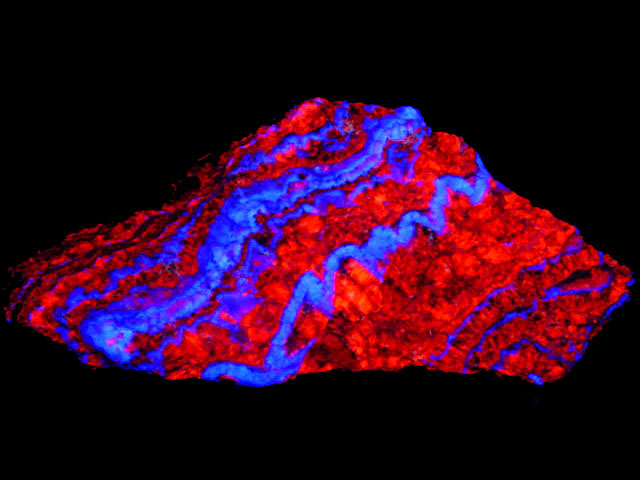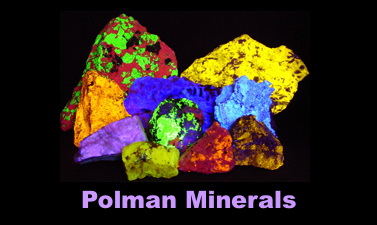1) Do I need a midrange ultraviolet lamp?
By far the number one question I get asked. As far as I know, all you “need” is love (big Beatle fan). I think the better question is “is it advantageous to have midrange?” My answer is “yes”, especially if you are serious about getting into the hobby of fluorescent mineral collecting. Over the past 20 years or so we have found that some mineral specimens will fluoresce brighter under midrange ultraviolet light (UVB) than they do under shortwave ultraviolet light (UVC). Minerals such as agrellite, apatite and many of the calcites from the desert southwest and Mexico, will fluoresce more brightly under UVB. There are some minerals that will fluoresce a completely different color under UVB than they will under UVC. There are some scheelites from China for example, that will fluoresce typical sky blue under UVC and fluoresce red under UVB. Some of the calcite from Challenger Cave in Mexico will fluoresce a creamy yellow under UVB, a pinkish blue under UVC and pink under longwave ultraviolet light (UVA). UVB may also help to balance out the color and brightness of two or more fluorescent minerals in a specimen. My favorite example of this are the calcite/fluorite specimens from the Pure Potential Mine in Arizona. The UVB tends to mute the brightness of the fluorite (which fluoresces best under UVA), and then brightens the calcite. The result is a very aesthetic mix of purple and red (see below).

Some people purchase lamps with just UVA and UVC due to the cost of adding the UVB. However, I recommend you get all three wavelengths in the same lamp if you can afford it. Down the road, you will find it very convenient to have all three wavelengths within one lamp housing. With all three wavelengths in one housing, you also have the option of substituting your UVB bulb for another UVC bulb. This doubles your UVC output, which can be very handy in the field. Some people say that all you really need in the field is UVC. That is true to some extent. This is because the amount of UV energy produced by UVC will usually cause any fluorescent mineral to fluoresce slightly (even minerals that fluoresce best with UVA may fluoresces slightly under UVC). Without knowing the true brightness of a specimen while in the field, you may end up collecting a bunch of specimens, just to be disappointed when you get home. I prefer to field test specimens to see if they are good enough for me to keep, especially if it’s a long hike back to the truck!! Collecting ethics also dictate “take only what you can use, leave the rest for others”.
2) How do I know if my glasses will block ultraviolet light?
If you have prescription glasses with lenses made of glass, you will be protected from UVB and UVC. UVA will pass through those lenses. Although not considered harmful, studies have shown that long term exposure to UVA may be the cause of cataracts. If the lenses of your prescription glasses, or any safety glasses you are using, are made of polycarbonate, acrylic or any plastic, then they may or may not block all UV wavelengths. Check and see if the glasses you are using have a UV rating. If they are rated as UV-400, that means that they will block all wavelengths shorter than 400 nanometers (nm). That includes all the UV wavelengths, UVA, UVB and UVC. If your glasses only say “UV protection”, I would not trust them for use with high powered ultraviolet lamps. I currently have two models of UV protective glasses for sale. The UVEX glasses have a rating of UV-385, which means that they allow a very small amount of UVA to pass. The Guardian Pro glasses have a rating of UV-400, which will block all UV light from passing. Both glasses have been tested by an independent laboratory, with the resulting transmission curves provided on this website. To see the UV protective glasses I have for sale, or the transmission curves, click here.
3) Can I use a fish tank to make a fluorescent mineral display?
I normally do not recommend using fish tanks for fluorescent mineral displays, although you can use them if you want/have to. If you do decide to use a fish tank, there are a couple of things that I recommend you do first. The first thing is to understand what tin side or float side of glass is. For that I recommend reading the information I provide on this website. Click here to go to that page. Once you determine if you will have a problem with the fish tank glass, then you can move forward from there. If you must use a fish tank, I would recommend painting the glass on the back and sides, and only allow the front to be clear. I recommend a flat black paint, not a gloss black. I tend to believe that any reflection of visible light in a case takes away from the overall aesthetics. I am also a big believer in shelves or risers, as opposed to just putting specimens on the bottom of a display. Since people are usually viewing a display horizontally, I believe it is best to have the best face of each specimen facing forward, not upward. Facing specimens forward, also faces them toward the UV light source (when the lamp is placed correctly toward the front of the case, and angled to provide the most UV energy to that specimen).
4) Do some fluorescent mineral specimens make good investments?
The short answer to this question is yes. However, like any other collectible investment, you should not go willy nilly into buying things without educating yourself first. The very first thing you need to do is find a very knowledgeable and trustworthy dealer. A dealer who has been in the business for a very long time will have a much better understanding of the investment potential of certain specimens with time. With the Franklin Mine in New Jersey producing some of the best fluorescent specimens in the world, and being closed since 1955, there certainly is the possibility to acquire specimens from there that will appreciate in value over time. Only someone who has been following specimen prices for many years will be qualified to assist you in purchasing fluorescent mineral specimens as “investments”.
